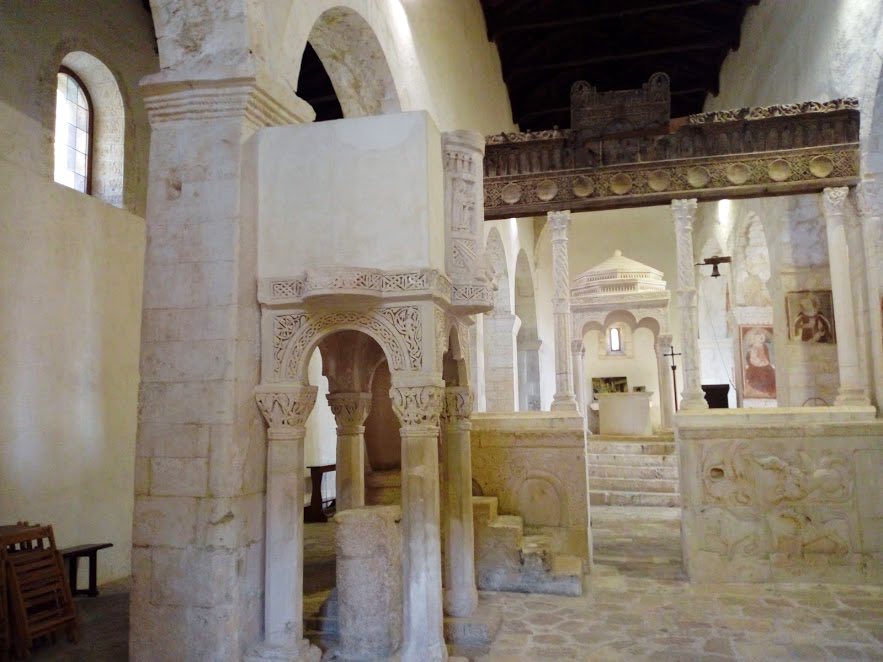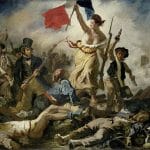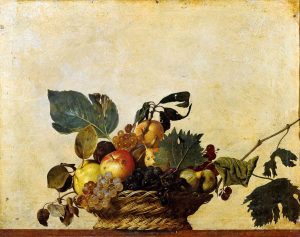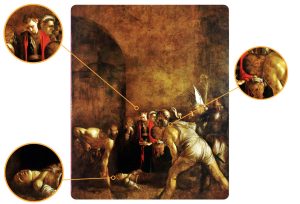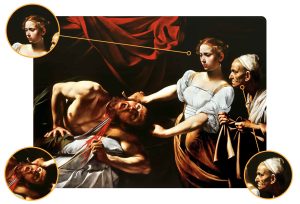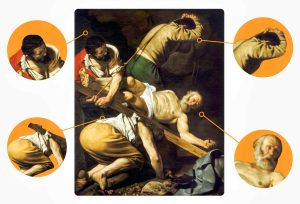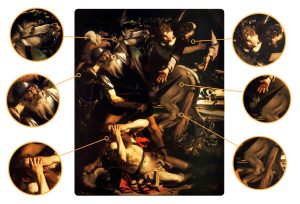Read this article in Italian (Leggi questo articolo in italiano) →
The perfect balance and harmony that govern the elements present in the church of Santa Maria in the Porclaneta in Rosciolo, Abruzzo, Italy, tends to arouse one’s curiosity with regards to its origins and history. Although much has already been said by historians and art experts, I firmly believe there are still many secrets hidden in the iconography the church is steeped in.
Unexplored secrets
Until now the elements that have found greater exposure in the historical and stylistic examination are the sculptural ones. However, I believe that the paintings in the church of Santa Maria, despite the simplicity of execution of some of them, still have much to reveal. This is particularly true of the triptych placed at the end of the right nave of the church. Here, the Virgin and Child is flanked by St. Michael holding scales in his hands and a saint with a long liturgical robe grasping a chain: St. Leonard of Noblat (also known as San Leonardo de Noblac, from the Latin ‘nobiliacum’).
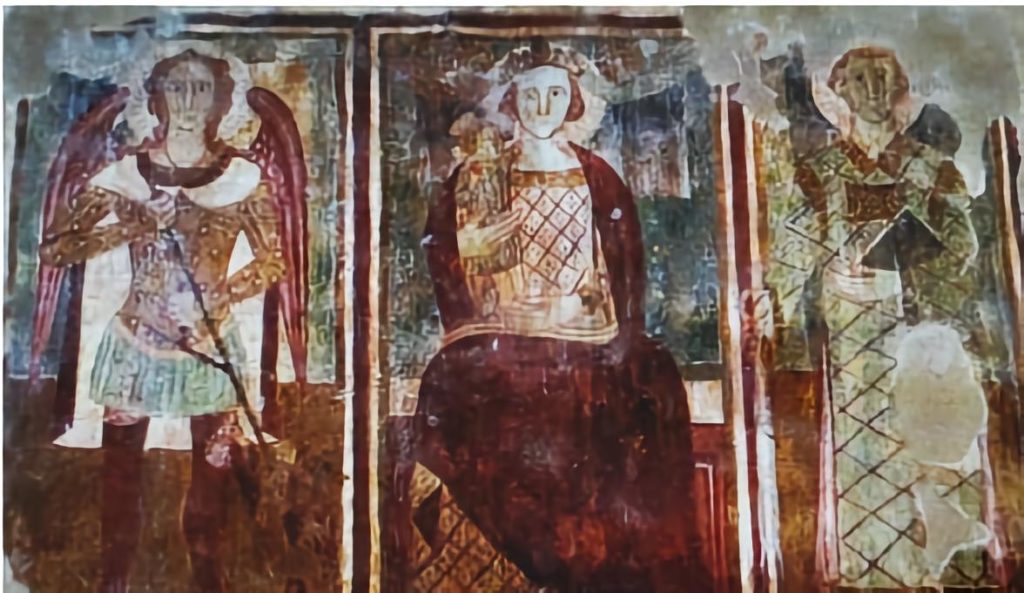
Many, myself included, have above all studied the most well-known iconographic elements in the triptych, such as the objects in the hands of Michael the archangel and the position of the Child in the arms of the Virgin, without paying due attention to the third figure of the fresco, St. Leonard. This oversight is probably due to the fact that the saint, despite having been the centre of a popular cult around Italy during the Middle Ages, is today mostly unknown. The facts concerning him and above all the historical implications connected to them are extremely interesting.
The journey of research to get to know this character better, like any course of study, must begin by taking small steps. It is therefore necessary to start by examining the historical sources on St. Leonard to try to justify and understand the spread of the cult. Leonard, a native of Gaul, lived most of his existence as a hermit. The dates concerning him lack historical certainty, however, most likely he was born in Limoges in 496, while his ‘dies natalis’ is celebrated on November 6 (probable date of the saint’s death: November 6, 545).
Leonard’s links to Clovis
Of noble origins, he had King Clovis, a friend of Leonardo’s parents, as his godfather. Clovis, the king who is remembered for having definitively renounced the pagan rites in France, played a key role in Leonard’s life and was subsequently in some way responsible for the inspiration of some of the aspects of his cult and of the iconographic elements attributable to the saint. Clotilde, the wife of Clovis, was the first person according to the hagiographic information on the life of Leonard to receive a miraculous intercession with God thanks to the holy hermit while the latter was still alive. It is said that Leonard’s prayers prevented the death of Clotilde and the baby (and therefore heir) she was carrying, saving them both from problems at the time of delivery. This fact subsequently determined the choice of Leonardo as protector of pregnant women. The cult for the saint was not limited to this and he was also invoked by farmers as a defender of livestock and shepherds.
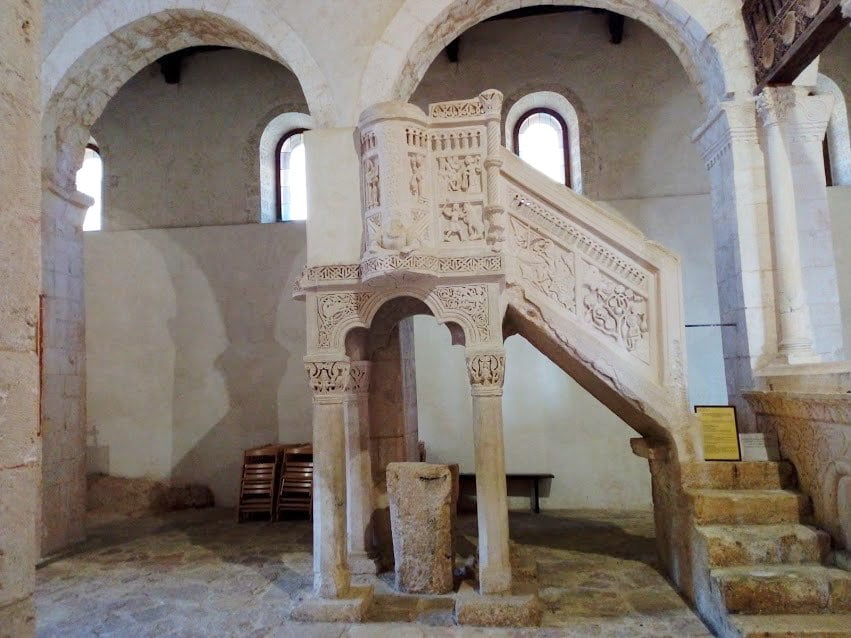
Moreover, St. Leonard is venerated as the protector of prisoners, especially those who had been unjustly incarcerated. This last aspect is also linked to Clovis. In fact, the king, perceiving Leonardo’s sanctity, granted him an extremely important task, namely the possibility of freeing those who he perceived as having been unjustly incarcerated. This faculty justifies the constant presence of chains in the frescoes that depict him and for this reason he is also the patron of chain builders.
Justice in the years in which the saint lived was rather arbitrary. The early Middle Ages and the following centuries may not have been as dark a historical moment as common opinion believes, but they were marked by disputes, power struggles and longing for prestige. These elements often led to unlawful arrests that were carried out simply to increase the personal power of some.
Moving forward from the historical context
Having made these brief, but necessary, hagiographic clarifications, it is now possible to examine the fresco of Santa Maria in Valle Porclaneta. The dating proposed by scholars places it roughly at the beginning of the 15th century. In the triptych, the saint wears a long liturgical robe, with one hand holding a book that could be a sacred text, but could also represent the deed issued by Clovis to free prisoners not guilty of crime, in his other hand he holds the chains. Leonard, who as we have said, was invoked by women in labour, in a historical context in which childbirth was among the main causes of death among young women, is depicted next to the Virgin, whose birth according to the scriptures took place in extreme environmental conditions.
The other element of the triptych is St. Michael the Archangel in the guise of a psychopomp, that is with a balance in his hands used to weigh the souls of the dead. One of the most immediate and shared interpretative readings of the fresco is the one that sees behind the images represented a hope, that of the faithful, who through the intercession of Leonardo, Maria and Michele believed they could break the chains of sin in order to overcome the test of the weighing of the soul by Michele. I firmly believe that this hypothesis, although entirely plausible and immediate, is not the only one. In fact, the chains must not be seen only as a symbol of sin, but mainly as iconographic attributes identifying Leonardo and his role as liberator of prisoners; precisely for this reason they cannot and must not be the only interpretative solution of the fresco.
The reading of the images must take into account every aspect of the cult and every prerogative of the subjects depicted. The fact that Michele and Leonardo shared the same role should not be considered secondary, both were protectors of the shepherds and in Rosciolo the local economy was widely characterized by pastoralism. For this reason, these saints were particularly dear to the local population. Mary completing the triptych was a further guarantee of protection and salvation for the faithful.
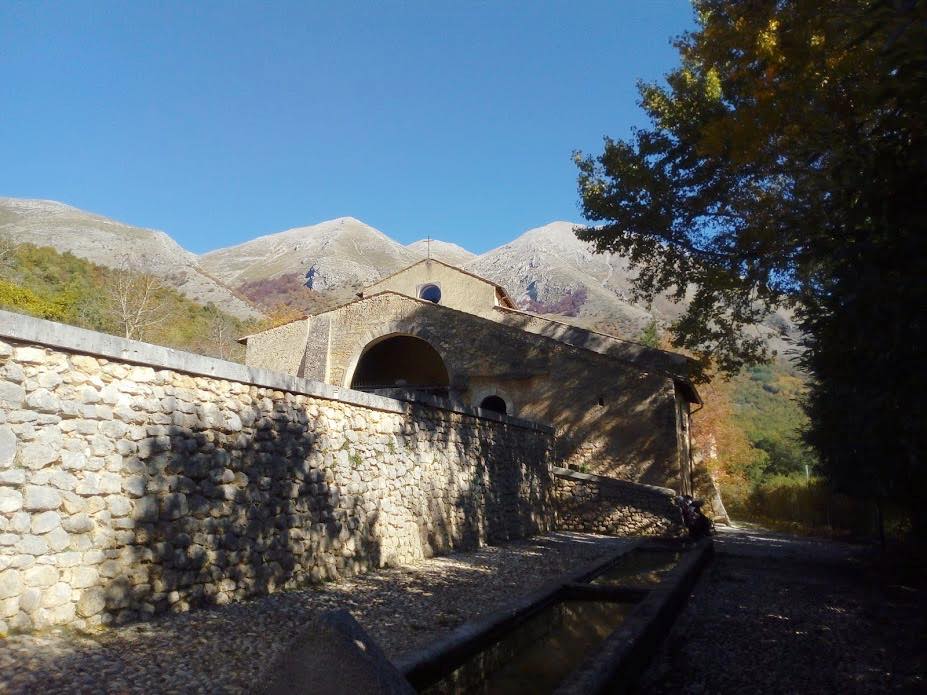
Numerous and natural exchanges
The interpretations proposed so far explain the possible reasons for the fresco, but do not help to understand how a cult, born in a geographical area so far from Abruzzo, ended up in Rosciolo. The hypothesis shared by many historians, which sees the transmission of this and other forms of religiosity to the influence exercised by the Normans when they had control of southern Italy, certainly remains valid, even for me. However, in my opinion, we must be careful not to think of the acquisition of elements typical of foreign people solely as a cultural imposition. It is necessary to look more introspectively and think about the numerous exchanges, which we could define as completely natural, that exist between two different cultures when they come into contact with each other. Very often there is a tendency to imagine the past and the places hosting the ancient works as crystallized, closed and suspended in a bubble. Obviously, this is not the case; exchanges, travels and contacts also took place in the past. Often, among the people who more than others were on the move, we find shepherds. The Normans also fall within the discourse linked to pastoralism and the movement of shepherds, because when they incorporated Abruzzo and Puglia to the Kingdom of Sicily, they gave new vitality to transhumance.
During the winter, the shepherds resumed their pastoral tracts, with greater guarantees of control, starting from Rosciolo, they rejoined the royal pastures to reach southern Italy. The journeys of the shepherds had several points in common with those of pilgrims who, after the reconquest of sacred sites by Christian knights, had begun to move in large numbers to make their journeys of faith. Since the final destination of these routes was, in most cases, the Holy Land or Santiago de Compostela, a stop in Rome to pray at the burial place of Peter, prince of the apostles could not be missed. From here the faithful then left to embark for southern Italy to conclude their journey.
Faith in the period we are examining was not so much a spiritual and inner phenomenon, but rather something that people felt the need to externalise in order to make it as tangible as possible. For example, during pilgrimages, the faithful were recognisable through concrete signs such as personal clothing or the transport of sacred images that were held up as trophies to be displayed. The shepherds who left our lands, therefore, would be able to meet and observe the faithful, including numerous Normans on their way to Santiago de Compostela, often following a path that started from Noblat, at the tomb of Leonard. To understand how important and frequent pilgrimages to and from Noblat were in the mentality and religiousness of the Normans, just think that Richard the Lionheart, King of England and Duke of Normandy, went directly to Leonard’s tomb as soon as he was freed from captivity in order to thank him for the freedom he regained.
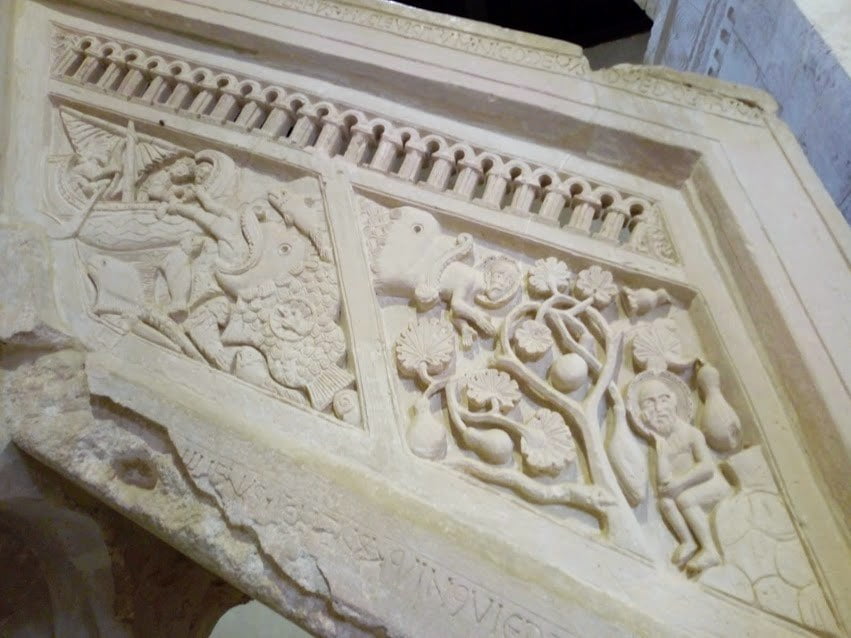
Collaboration between art history and anthropology
Surely the habits, encounters and ways of living, which according to my interpretation, are behind the choice of the subjects depicted in the triptych, belong more to an anthropological than a historical sphere. Nevertheless, I believe that the collaboration between art history and anthropology, although not always considered valid because it may not be entirely verifiable, can prove to be an excellent key to interpreting works of art and the cultural contaminations within them. The oral tradition and the persistence of traditions handed down from generation to generation, can hence be of help in filling any gaps or absences of official documents by providing new and interesting insights into the study of the forms and contents of art.
• Carla Pietrobattista was born on November 10, 1978, in Avezzano in a culturally stimulating family. She grew up and still lives in a characteristic town in the province of L’Aquila: Magliano dei Marsi. She is the Grandniece of Father Panfilo Pietrobattista da Magliano, founder and first president of Saint Bonaventure in America. She had a humanistic education culminating in a degree from the University of Perugia in June 2004, discussing a thesis in Christian archeology on the Celimontana Church of Saints John and Paul. Carla worked as an art expert and is currently teaching and working on cultural assignments to promote the artistic culture of her territory.



